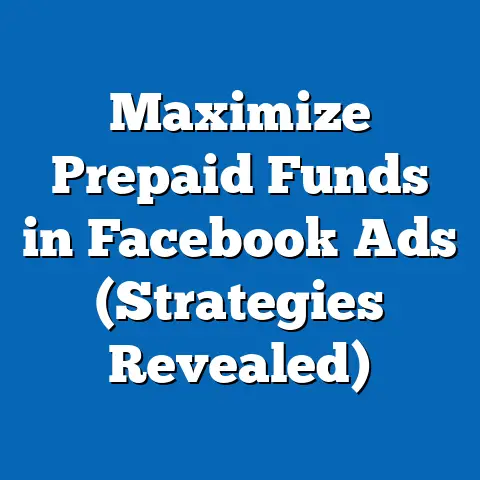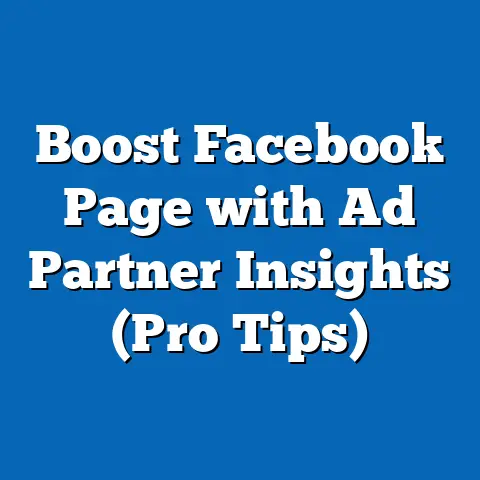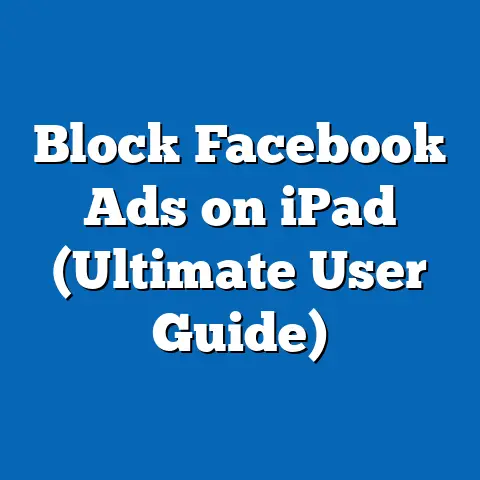Boost Sales with Facebook Ads for Shopify (Expert Strategies)
The Hidden Benefits of Facebook Ads for Shopify Stores
Facebook Ads offer more than just a platform to display products; they provide a unique ecosystem for Shopify merchants to connect with customers in ways that other channels can’t replicate. One hidden benefit is the ability to tap into micro-targeting based on user behavior, interests, and even life events, allowing for hyper-personalized campaigns. Additionally, the platform’s integration with Shopify through tools like the Facebook Shop and dynamic ads enables seamless product syncing and automated retargeting, saving time and boosting efficiency.
Another often-overlooked advantage is the platform’s ability to drive impulse purchases through visually engaging formats like carousel ads and video ads. According to a 2022 study by Hootsuite, 54% of social media users have made a purchase directly influenced by an ad they saw on a platform like Facebook. For Shopify stores, this means an opportunity to convert browsers into buyers with the right creative strategy.
Lastly, Facebook Ads provide unparalleled insights through the Ads Manager and Pixel tracking, offering Shopify merchants real-time data on customer behavior, ad performance, and return on ad spend (ROAS). This data-driven approach allows for continuous optimization, a critical factor in staying competitive in the fast-paced e-commerce landscape. As we dive deeper, let’s look at the numbers and trends that underscore why Facebook Ads are a game-changer for Shopify businesses.
Key Statistics and Trends: Why Facebook Ads Matter for Shopify
Facebook remains one of the most powerful advertising platforms globally, with over 2.9 billion monthly active users as of 2023, according to Statista. This massive user base offers Shopify merchants an unparalleled opportunity to reach diverse audiences across demographics and geographies. For context, approximately 60% of internet users worldwide are on Facebook, making it a prime channel for customer acquisition.
When it comes to e-commerce, Facebook Ads have proven their effectiveness in driving sales. A 2023 report by DataReportal revealed that 78% of online shoppers discover products through social media, with Facebook leading as the top platform for product discovery. Furthermore, Shopify-specific data from Oberlo indicates that businesses using Facebook Ads see an average ROAS of 3.5x, meaning for every $1 spent, they generate $3.50 in revenue.
Trends also show a shift toward mobile-first advertising, with 98% of Facebook users accessing the platform via mobile devices (Statista, 2023). For Shopify stores, this emphasizes the importance of mobile-optimized ads and landing pages to capture this dominant user segment. Additionally, video content continues to dominate engagement, with video ads on Facebook generating 6.09% higher click-through rates (CTR) compared to static image ads, per a 2022 WordStream analysis.
Demographic Insights: Who Are You Targeting on Facebook?
Understanding the demographics of Facebook users is crucial for Shopify merchants crafting effective ad campaigns. As of 2023, the largest age group on Facebook is 25-34 years old, accounting for 29.9% of users globally, followed by the 18-24 age group at 23.5%, according to Statista. This skew toward younger and middle-aged adults aligns well with typical e-commerce target audiences, who are often active online shoppers.
Gender distribution on the platform is relatively balanced, with 56.3% male users and 43.7% female users worldwide. However, studies by Sprout Social (2023) show that women tend to engage more with brand content and are 18% more likely to click on ads related to fashion, beauty, and home goods—key niches for many Shopify stores. Men, on the other hand, show higher engagement with tech and gaming-related ads.
Geographically, Facebook’s user base is heavily concentrated in Asia-Pacific (44% of users), followed by Europe (14%) and North America (10%). For Shopify merchants targeting international markets, this highlights the potential to scale globally using localized ad campaigns. Demographic targeting tools in Facebook Ads Manager allow merchants to tailor messaging based on location, language, and cultural nuances, ensuring relevance and higher conversion rates.
Historical vs. Current Data: Evolution of Facebook Ads for E-Commerce
Looking at historical trends, Facebook Ads have evolved significantly since their introduction in 2007. Initially, the platform focused on basic display ads with limited targeting options. By 2012, with the introduction of the Facebook Pixel, advertisers gained the ability to track user behavior and retarget website visitors—a game-changer for e-commerce businesses.
Historically, the average cost-per-click (CPC) for Facebook Ads was much lower, averaging $0.27 in 2010, compared to $1.72 in 2023, according to WordStream data. This increase reflects growing competition and the platform’s enhanced targeting capabilities. However, despite higher costs, the effectiveness of ads has improved, with average conversion rates rising from 2.5% in 2015 to 9.21% in 2023 for e-commerce campaigns (WordStream, 2023).
For Shopify merchants, the integration of Facebook Ads with the Shopify platform has also advanced. The introduction of dynamic product ads in 2015 allowed for automated product retargeting, while the 2020 launch of Facebook Shops enabled direct in-app purchases. These developments have made it easier for merchants to bridge the gap between ad exposure and final sale, contributing to a 30% increase in Shopify store conversions via social media channels between 2019 and 2023 (Shopify Analytics, 2023).
Expert Strategies to Boost Sales with Facebook Ads for Shopify
Now that we’ve established the value of Facebook Ads through data and trends, let’s dive into actionable strategies to maximize sales for your Shopify store. These expert tips are designed to help you navigate the complexities of ad creation, targeting, and optimization while ensuring a strong ROAS.
1. Leverage Shopify’s Native Integration with Facebook
Shopify’s built-in integration with Facebook allows merchants to sync their product catalog directly to the platform, enabling dynamic ads that automatically showcase relevant products to users. According to Shopify, stores using dynamic product ads see a 34% higher click-through rate compared to standard image ads. To get started, connect your Shopify store to Facebook via the Sales Channel in your dashboard and set up the Facebook Pixel for accurate tracking.
Ensure your product catalog is optimized with high-quality images, detailed descriptions, and accurate pricing. This integration also supports retargeting campaigns, which can recover up to 26% of abandoned carts, per a 2022 study by Baymard Institute. Use this feature to re-engage visitors who’ve shown interest but haven’t completed a purchase.
2. Master Audience Targeting for Precision
Facebook’s targeting options are among its most powerful features, allowing Shopify merchants to reach specific customer segments. Use custom audiences to target past customers or website visitors, as they’re 70% more likely to convert compared to cold audiences (Facebook Business Insights, 2023). Additionally, lookalike audiences can help you find new customers similar to your best-performing segments, often yielding a 2x higher conversion rate.
Layer demographic filters such as age, gender, and location with interest-based targeting to refine your audience further. For example, if you sell fitness apparel on Shopify, target users interested in “yoga,” “gym workouts,” or specific brands like Lululemon. Test multiple audience segments to identify which yields the highest ROAS, and adjust budgets accordingly.
3. Optimize Creative for Engagement and Conversions
The visual appeal of your ads plays a critical role in capturing attention and driving clicks. Video ads, for instance, have a 27% higher conversion rate than static ads for e-commerce businesses (WordStream, 2023). Create short, engaging videos (15-30 seconds) that highlight your product’s unique selling points, and include clear calls-to-action (CTAs) like “Shop Now” or “Get 20% Off.”
Carousel ads are another effective format for Shopify stores, allowing you to showcase multiple products in a single ad. A 2022 study by Hootsuite found that carousel ads generate 10 times more traffic to e-commerce sites compared to single-image ads. Use this format to display a range of products or highlight different features of a single item, linking directly to your Shopify product pages.
4. Implement Retargeting Campaigns to Recover Lost Sales
Retargeting is a powerful tool for Shopify merchants, as it targets users who have already interacted with your store but didn’t convert. According to a 2023 report by Criteo, retargeted ads have a 76% higher click-through rate compared to standard display ads. Use the Facebook Pixel to track visitors who viewed products, added items to their cart, or initiated checkout, and serve them tailored ads with incentives like discounts or free shipping.
For example, create a dynamic retargeting ad that shows the exact product a user abandoned, paired with a limited-time offer. Shopify data indicates that retargeting campaigns can increase conversion rates by up to 43% when paired with personalized messaging. Test different ad copy and offers to find the most effective combination for your audience.
5. Utilize A/B Testing for Continuous Improvement
A/B testing (or split testing) is essential for optimizing Facebook Ads performance. Test variables such as ad copy, visuals, CTAs, and audience segments to determine what resonates best with your target market. According to HubSpot, businesses that run A/B tests on their ads see a 37% improvement in conversion rates on average.
Start by testing two versions of an ad with a single variable changed—for instance, one with a discount offer (“Save 15% Today”) and another with a scarcity tactic (“Only 5 Left in Stock”). Allocate a small budget to each variant, monitor performance metrics like CTR and conversion rate, and scale the winning version. Shopify merchants can use the built-in analytics alongside Facebook Ads Manager to track results and make data-driven decisions.
6. Focus on Mobile Optimization
Given that 98% of Facebook users access the platform via mobile, optimizing your ads and Shopify store for mobile is non-negotiable. Ensure your ad creatives are formatted for smaller screens, with bold visuals and concise text that’s easy to read. A 2023 study by Mobile Marketer found that mobile-optimized ads achieve a 15% higher conversion rate compared to non-optimized ones.
Additionally, test your Shopify store’s mobile responsiveness to ensure a seamless shopping experience. Slow load times or poor navigation can deter potential customers, with 40% of users abandoning sites that take more than 3 seconds to load (Google, 2022). Use tools like Google PageSpeed Insights to identify and fix issues, and prioritize mobile-first design in your ad-to-checkout funnel.
7. Monitor and Optimize Ad Spend for Maximum ROAS
Budget management is critical to achieving a strong return on investment with Facebook Ads. Start with a modest daily budget (e.g., $10-$20) to test campaigns, and scale up once you identify high-performing ads. Shopify data shows that merchants who actively monitor and adjust their ad spend achieve a 25% higher ROAS compared to those who set it and forget it.
Use Facebook’s Campaign Budget Optimization (CBO) feature to automatically distribute your budget across top-performing ad sets. Additionally, track key metrics like cost-per-acquisition (CPA) and lifetime customer value (LTV) to ensure long-term profitability. For instance, if your average CPA is $15 but your customer LTV is $50, you’re in a strong position to scale ad spend while maintaining profitability.
8. Capitalize on Seasonal and Event-Based Campaigns
Seasonal events and holidays offer Shopify merchants a prime opportunity to boost sales through Facebook Ads. According to the National Retail Federation, holiday spending in 2022 reached $936.3 billion in the U.S. alone, with a significant portion driven by online sales. Create themed campaigns for major events like Black Friday, Cyber Monday, or Valentine’s Day, and use urgency-driven messaging to encourage quick purchases.
Tailor your ads to specific holidays by incorporating relevant visuals and offers. For example, a Shopify store selling gifts could run a “Last-Minute Christmas Deals” campaign in early December, targeting procrastinating shoppers. Historical data from Facebook shows that holiday ad campaigns achieve a 20% higher engagement rate compared to non-seasonal ads, making this a lucrative strategy.
Data Visualization Description: Mapping Your Campaign Success
To help visualize the impact of these strategies, imagine a dashboard-style chart tracking key metrics over a 3-month Facebook Ads campaign for a Shopify store. The first line graph would show a steady increase in ROAS, starting at 2.5x in month one and peaking at 4.2x by month three after implementing retargeting and A/B testing. A bar chart could compare CTR across ad formats, with video ads leading at 3.1%, followed by carousel ads at 2.8%, and static ads at 1.5%.
A pie chart would break down audience demographics, illustrating that 60% of conversions come from the 25-34 age group, 30% from 18-24, and 10% from 35-44. Finally, a heatmap of ad spend distribution would highlight peak performance during holiday weekends, reinforcing the importance of event-based campaigns. These visualizations, if created in tools like Tableau or Google Data Studio, can guide Shopify merchants in refining their strategies based on real-time data.
Challenges and Considerations for Shopify Merchants
While Facebook Ads offer immense potential, there are challenges to navigate. Rising ad costs, as mentioned earlier, require careful budget planning to maintain profitability. Additionally, changes in privacy policies, such as Apple’s iOS 14 update in 2021, have impacted tracking capabilities, with 62% of marketers reporting reduced ad effectiveness due to limited data access (eMarketer, 2023).
To mitigate these issues, focus on first-party data collection through your Shopify store, such as email sign-ups and customer surveys, to build custom audiences. Additionally, diversify traffic sources by combining Facebook Ads with other channels like Google Ads or Instagram to avoid over-reliance on a single platform. Staying updated on policy changes and adapting to new tools, like Facebook’s Conversions API, can also help maintain campaign performance.
Broader Implications and Future Trends
The role of Facebook Ads in e-commerce, particularly for Shopify merchants, is only set to grow as the platform continues to innovate. Emerging trends like augmented reality (AR) ads, which allow users to “try on” products virtually, are gaining traction, with 35% of consumers expressing interest in AR shopping experiences (Statista, 2023). Shopify stores that adopt early can gain a competitive edge in customer engagement.
Additionally, the increasing importance of social commerce—where purchases happen directly within the app—suggests that Facebook Shops will play a larger role in driving sales. Shopify data predicts that by 2025, 50% of e-commerce revenue for small businesses could come from social platforms. Merchants who prioritize seamless integration and user-friendly experiences will be best positioned to capitalize on this shift.
In conclusion, Facebook Ads offer Shopify merchants a powerful tool to boost sales through precise targeting, engaging creatives, and data-driven optimization. By leveraging the strategies outlined— from audience segmentation to seasonal campaigns—businesses can achieve sustainable growth and a strong ROAS. As the digital landscape evolves, staying agile and embracing new features will ensure long-term success in the competitive world of e-commerce.





